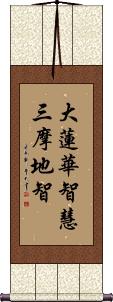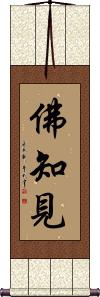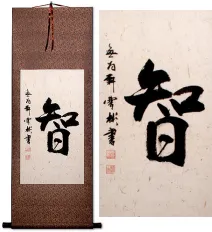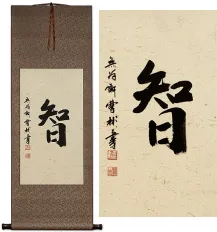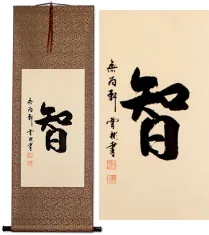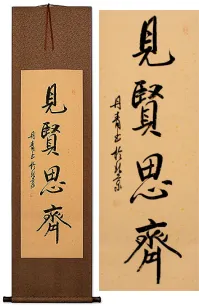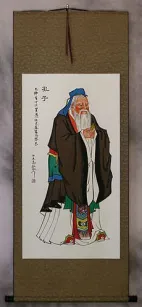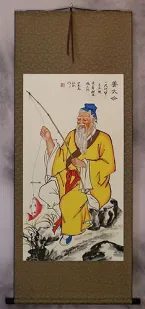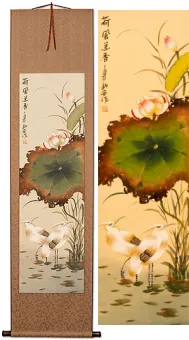Many custom options...
And formats...

Not what you want?
Try other similar-meaning words, fewer words, or just one word.
Wisdom Lotus in Chinese / Japanese...
Buy a Wisdom Lotus calligraphy wall scroll here!
Personalize your custom “Wisdom Lotus” project by clicking the button next to your favorite “Wisdom Lotus” title below...
Wisdom Lotus
Mystic Lotus Wisdom of Amitabha
Great Lotus Wisdom - Samadhi Wisdom
Wisdom and Insight of the Buddha
This in-stock artwork might be what you are looking for, and ships right away...
Gallery Price: $150.00
Your Price: $78.88
Gallery Price: $150.00
Your Price: $78.88
Gallery Price: $65.00
Your Price: $39.88
Gallery Price: $100.00
Your Price: $49.88
Gallery Price: $108.00
Your Price: $59.88
Gallery Price: $61.00
Your Price: $33.88
Gallery Price: $61.00
Your Price: $33.88
Gallery Price: $61.00
Your Price: $33.88
Not the results for wisdom lotus that you were looking for?
Below are some entries from our dictionary that may match your wisdom lotus search...
| Characters If shown, 2nd row is Simp. Chinese |
Pronunciation Romanization |
Simple Dictionary Definition |
妙蓮華 妙莲华 see styles |
miào lián huá miao4 lian2 hua2 miao lien hua myō renge |
More info & calligraphy: Wisdom Lotus |
蓮華智 莲华智 see styles |
lián huá zhì lian2 hua2 zhi4 lien hua chih renge chi |
More info & calligraphy: Mystic Lotus Wisdom of Amitabha |
大蓮華智慧三摩地智 大莲华智慧三摩地智 see styles |
dà lián huá zhì huì sān mó dì zhì da4 lian2 hua2 zhi4 hui4 san1 mo2 di4 zhi4 ta lien hua chih hui san mo ti chih dai renge chie sanmajichi |
More info & calligraphy: Great Lotus Wisdom - Samadhi Wisdom |
五時 五时 see styles |
wǔ shí wu3 shi2 wu shih goji |
(五時教) The five periods or divisions of Śākyamuni's teaching. According to Tiantai they are (1) 華嚴時 the Avataṃsaka or first period in three divisions each of seven days, after his enlightenment, when he preached the content, of this sutra; (2) 鹿苑時 the twelve years of his preaching the Āgamas 阿含 in the Deer Park; (3) 方等時 the eight years of preaching Mahāyāna-cum-Hīnayāna doctrines, the vaipulya period; (4) 般若時 the twenty-two years of his preaching the prajñā or wisdom sutras; (5) 法華涅槃時 the eight years of his preaching the Lotus Sutra and, in a day and a night, the Nirvana Sutra. According to the Nirvana School (now part of the Tiantai) they are (1) 三乘別教 the period when the differentiated teaching began and the distinction of the three vehicles, as represented by the 四諦 Four Noble Truths for śrāvakas, the 十二因緣 Twelve Nidānas for pratyekabuddhas, and the 六度 Six Pāramitās for bodhisattvas; (2) 三乘通教 the teaching common to all three vehicles, as seen in the 般若經; (3) 抑揚教 the teaching of the 維摩經, the 思益梵天所問經, and other sutras olling the bodhisattva teaching at the expense of that for śrāvakas; (4) 同歸教 the common objective teaching calling all three vehicles, through the Lotus, to union in the one vehicle; (5) 常住教 the teaehmg of eternal life i. e. the revelation through the Nirvana sutra of the eternity of Buddhahood; these five are also called 有相; 無相; 抑揚; 曾三歸—; and 圓常. According to 劉虬 Liu Chiu of the 晉 Chin dynasty, the teaching is divided into 頓 immediate and 漸 gradual attainment, the latter having five divisions called 五時教 similar to those of the Tiantai group. According to 法寶 Fabao of the Tang dynasty the five are (1) 小乘; (2) 般着 or 大乘; (3) 深密 or 三乘; (4) 法華 or 一乘; (5) 涅槃 or 佛性教. |
五觀 五观 see styles |
wǔ guān wu3 guan1 wu kuan gokan |
The five meditations referred to in the Lotus Sutra 25: (1) 眞 on the true, idem 空觀, to meditate on the reality of the void or infinite, in order to be rid of illusion in views and thoughts; (2) 淸淨觀 on purity, to be rid of any remains of impurity connected with the temporal, idem 假觀; (3) 廣大智慧觀 on the wider and greater wisdom, idem 中觀, by study of the 'middle' way; (4) 悲觀 on pitifulness, or the pitiable condition of the living, and by the above three to meditate on their salvation; (5) 慈觀 on mercy and the extension of the first three meditations to the carrying of joy to all the living. |
十妙 see styles |
shí miào shi2 miao4 shih miao jūmyō |
The ten wonders, or incomprehensibles; there are two groups, the 迹v traceable or manifested and 本門妙 the fundamental. The 迹門十妙 are the wonder of: (1) 境妙 the universe, sphere, or whole, embracing mind, Buddha, and all things as a unity; (2) 智妙 a Buddha's all-embracing knowledge arising from such universe; (3) 行妙 his deeds, expressive of his wisdom; (4) 位妙 his attainment of all the various Buddha stages, i.e. 十住 and十地; (5) 三法妙 his three laws of 理, 慧, and truth, wisdom, and vision; (6) 感應妙 his response to appeal, i.e. his (spiritual) response or relation to humanity, for "all beings are my children"; (7) 神通妙 his supernatural powers; (8) 說法妙 his preaching; (9) 眷屬妙 his supernatural retinue; (10) 利益妙 the blessings derived through universal elevation into Buddhahood. The 本門十妙 are the wonder of (1) 本因妙 the initial impulse or causative stage of Buddhahood; (2) 本果妙 its fruit or result in eternity, joy, and purity; (3) 國土妙 his (Buddha) realm; (4) 感應妙 his response (to human needs); (5) 神通妙 his supernatural powers; (6) 說法妙 his preaching; (7) 眷屬妙 his supernatural retinue; (8) 涅槃妙 his nirvāṇa; (9) 壽命妙 his (eternal) life; (10) his blessings as above. Both groups are further defined as progressive stages in a Buddha's career. These "wonders" are derived from the Lotus sūtra. |
四法 see styles |
sì fǎ si4 fa3 ssu fa shihō |
There are several groups of four dharma: (1) 教法 the teaching of the Buddha); 理法 its principles, or meaning; 行法 its practice; 果法 its fruits or rewards. (2) Another group relates to bodhisattvas, their never losing the bodhi-mind, or the wisdom attained, or perseverance in progress, or the monastic forest life (āraṇyaka). (3) Also 信解行證 faith, discernment, performance, and assurance. (4) The Pure-land 'True' sect of Japan has a division: 教法, i. e. the 大無量壽經; 行法 the practice of the seventeenth of Amitābha's vows; 信法 faith in the eighteenth; and 證法 proof of the eleventh. The most important work of Shinran, the founder of the sect, is these four, i. e. 教行信證. (5) A 'Lotus ' division of 四法 is the answer to a question of Puxian (Samantabhadra) how the Lotus is to be possessed after the Buddha's demise, i. e. by thought (or protection) of the Buddhas; the cultivation of virtue; entry into correct dhyāna; and having a mind to save all creatures. |
大日 see styles |
dà rì da4 ri4 ta jih dainichi だいにち |
Mahavairocana (Tathagata); Great Sun; Supreme Buddha of Sino-Japanese esoteric Buddhism; (place-name, surname) Dainichi Vairocana, or Mahāvairocana 大日如來; 遍照如來; 摩訶毘盧遮那; 毘盧遮那; 大日覺王 The sun, "shining everywhere" The chief object of worship of the Shingon sect in Japan, "represented by the gigantic image in the temple at Nara." (Eliot.) There he is known as Dai-nichi-nyorai. He is counted as the first, and according to some, the origin of the five celestial Buddhas (dhyāni-buddhas, or jinas). He dwells quiescent in Arūpa-dhātu, the Heaven beyond form, and is the essence of wisdom (bodhi) and of absolute purity. Samantabhadra 普賢 is his dhyāni-bodhisattva. The 大日經 "teaches that Vairocana is the whole world, which is divided into Garbhadhātu (material) and Vajradhātu (indestructible), the two together forming Dharmadhātu. The manifestations of Vairocana's body to himself―that is, Buddhas and Bodhisattvas ―are represented symbolically by diagrams of several circles ". Eliot. In the 金剛界 or vajradhātu maṇḍala he is the center of the five groups. In the 胎藏界 or Garbhadhātu he is the center of the eight-leaf (lotus) court. His appearance, symbols, esoteric word, differ according to the two above distinctions. Generally he is considered as an embodiment of the Truth 法, both in the sense of dharmakāya 法身 and dharmaratna 法寳. Some hold Vairocana to be the dharmakāya of Śākyamuni 大日與釋迦同一佛 but the esoteric school denies this identity. Also known as 最高顯廣眼藏如來, the Tathagata who, in the highest, reveals the far-reaching treasure of his eye, i.e. the sun. 大日大聖不動明王 is described as one of his transformations. Also, a śramaņa of Kashmir (contemporary of Padma-saṃbhava); he is credited with introducing Buddhism into Khotan and being an incarnation of Mañjuśrī; the king Vijaya Saṃbhava built a monastery for him. |
大通 see styles |
dà tōng da4 tong1 ta t`ung ta tung daitsuu / daitsu だいつう |
see 大通區|大通区[Da4 tong1 Qu1]; see 大通回族土族自治縣|大通回族土族自治县[Da4 tong1 Hui2 zu2 Tu3 zu2 Zi4 zhi4 xian4] (surname) Daitsuu 大通智勝 Mahābhijñā Jñānābhibhu. The great Buddha of supreme penetraton and wisdom. "A fabulous Buddha whose realm was Sambhava, his kalpa Mahārūpa. Having spent ten middling kalpas in ecstatic meditation he became a Buddha, and retired again in meditation for 84,000 kalpas, during which his sixteen sons continued (as Buddhas) his preaching. Incarnations of his sons are," Akṣobhya, Merukūṭa, Siṃhaghoṣa, Siṃhadhvaja, Ākāśapratiṣṭhita, Nityapaṛvrtta, Indradhvaja, Brahmadhvaja, Amitābha, Sarvalokadhātū- padravodvegapratyuttīrna, Tamāla-patra-candanagandha, Merukalpa, Meghasvara, Meghasvararāja, Sarvaloka-bhayastambhitatva- vidhvaṃsanakāra, and Śākyamuni; v. Eitel. He is said to have lived in a kalpa earlier than the present by kalpas as numerous as the atoms of a chiliocosm. Amitābha is his ninth son. Śākyamuni his sixteenth, and the present 大衆 or assembly of believers are said to be the reincarnation of those who were his disciples in that former aeon; v. Lotus Sutra, chapter 7. |
文殊 see styles |
wén shū wen2 shu1 wen shu monju もんじゅ |
Manjushri, the Bodhisattva of keen awareness (Buddhist term) Manjushri; Manjusri; Bodhisattva that represents transcendent wisdom; (p,s,f) Monju (文殊師利) Mañjuśrī 滿殊尸利 -later 曼殊室利. 文殊 is also used for Mañjunātha, Mañjudeva, Mañjughoṣa, Mañjuṣvara, et al. T., hjamdpal; J., Monju. Origin unknown; presumably, like most Buddhas and bodhisattvas, an idealization of a particular quality, in his case of Wisdom. Mañju is beautiful, Śrī; good fortune, virtue, majesty, lord, an epithet of a god. Six definitions are obtained from various scriptures: 妙首 (or 頭 ) wonderful or beautiful) head; 普首 universal head; 濡首 glossy head (probably a transliteration); 敬首 revered head; 妙德 wonderful virtue (or power); 妙吉祥 wonderfully auspicious; the last is a later translation in the 西域記. As guardian of wisdom 智慧 he is often placed on Śākyamuni's left, with 普顯 on the right as guardian of law 理, the latter holding the Law, the former the wisdom or exposition of it; formerly they held the reverse positions. He is often represented with five curls or waves to his hair indicating the 五智 q. v. or the five peaks; his hand holds the sword of wisdom and he sits on a lion emblematic of its stern majesty: but he has other forms. He is represented as a youth, i. e. eternal youth. His present abode is given as east of the universe, known as 淸涼山 clear and cool mountain, or a region 寶住 precious abode, or Abode of Treasures, or 寶氏 from which he derives one of his titles, 寶相如來. One of his dhāraṇīs prophesies China as his post-nirvāṇa realm. In past incarnations he is described as being the parent of many Buddhas and as having assisted the Buddha into existence; his title was 龍種上佛 the supreme Buddha of the nāgas, also 大身佛 or 神仙佛; now his title is 歡喜藏摩尼寶精佛 The spiritual Buddha who joyfully cares for the jewel: and his future title is to be 普現佛 Buddha universally revealed. In the 序品 Introductory Chapter of the Lotus Sutra he is also described as the ninth predecessor or Buddha-ancestor of Śākyamuni. He is looked on as the chief of the Bodhisattvas and represents them, as the chief disciple of the Buddha, or as his son 法王子. Hīnayāna counts Śāriputra as the wisest of the disciples, Mahāyāna gives Mañjuśrī the chief place, hence he is also styled 覺母 mother, or begetter of understanding. He is shown riding on either a lion or a peacock, or sitting on a white lotus; often he holds a book, emblem of wisdom, or a blue lotus; in certain rooms of a monastery he is shown as a monk; and he appears in military array as defender of the faith. His signs, magic words, and so on, are found in various sutras. His most famous centre in China is Wu-tai shan in Shansi. where he is the object of pilgrimages, especially of Mongols. The legends about him are many. He takes the place in Buddhism of Viśvakarman as Vulcan, or architect, of the universe. He is one of the eight Dhyāni-bodhisattvas, and sometimes has the image of Akṣobhya in his crown. He was mentioned in China as early as the fourth century and in the Lotus Sutra he frequently appears, especially as the converter of the daughter of the Dragon-king of the Ocean. He has five messengers 五使者 and eight youths 八童子 attending on him. His hall in the Garbhadhātu maṇḍala is the seventh, in which his group numbers twenty-five. His position is northeast. There are numerous sutras and other works with his name as title, e. g. 文殊師利問菩提經 Gayaśīrṣa sūtra, tr. by Kumārajīva 384-417: and its 論 or .Tīkā of Vasubandhu, tr. by Bodhiruci 535. see list in B. N. |
智積 智积 see styles |
zhì jī zhi4 ji1 chih chi chishaku ちしゃく |
(place-name) Chishaku Jñānākara. Accumulation of knowledge. Eldest son of Mahābhijñā; also said to be Akṣobhya. Prajñākūṭa. A Bodhisattva in the retinue of Prabhūtratna, v. Lotus Sūtra. |
舍利 see styles |
shè lì she4 li4 she li shari |
(Buddhism) relic found in the cremated ashes of Buddhists (from Sanskrit "śarīra") (1) śārī, śārikā; a bird able to talk, intp. variously, but, M. W. says the mynah. Śārikā was the name of Śāriputra's mother, because her eyes were bright and clever like those of a mynah; there are other interpretation (2) śarīra(m). 設利羅 (or 室利羅); 實利; 攝 M004215 藍 Relics or ashes left after the cremation of a buddha or saint; placed in stupas and worhipped. The white represent bones; the black, hair; and the red, flesh. Also called dhātu-śarīra or dharma-śarīra. The body, a dead body. The body looked upon as dead by reason of obedience to the discipline, meditation, and wisdom. The Lotus Sutra and other sutras are counted as relics, Śākyamuni's relics are said to have amounted to 八斛四斗 84 pecks, for which Aśoka is reputed to have built in one day 84,000 stupas; but other figures are also given. śarīra is also intp. by grains of rice, etc., and by rice as food. |
三輪教 三轮教 see styles |
sān lún jiào san1 lun2 jiao4 san lun chiao sanrin kyō |
The three periods of the Buddha's teaching as defined by Paramārtha: (a) 轉法輪 the first rolling onwards of the Law-wheel, the first seven years' teaching of Hīnayāna, i.e. the 四諦 four axioms and 空 unreality; (b) 照法輪 illuminating or explaining the law-wheel, the thirty years' teaching of the 般若 prajñā or wisdom sūtras, illuminating 空 and by 空 illuminating 有 reality; (c) 持法輪 maintaining the law-wheel, i.e. the remaining years of teaching of the deeper truths of 空有 both unreality and reality. Also the three-fold group of the Lotus School: (a) 根本法輪 radical, or fundamental, as found in the 華嚴經 sūtra; (b) 枝末法輪 branch and leaf, i.e. all other teaching; until (c) 攝末歸本法輪 branches and leaves are reunited with the root in the Lotus Sutra, 法華經. |
不動佛 不动佛 see styles |
bù dòng fó bu4 dong4 fo2 pu tung fo Fudō Butsu |
不動如來; 阿閦鞞 or 阿閦婆, Akṣobhya, one of the 五智如來 Five Wisdom, or Dhyāni-Buddhas, viz., Vairocana, Akṣobhya, Ratnasambhava, Amitābha, and Amoghasiddhi. He is especially worshipped by the Shingon sect, as a disciple of Vairocana. As Amitābha is Buddha in the western heavens, so Akṣobhya is Buddha in the eastern heaven of Abhirati, the realm of joy, hence he is styled 善快 or 妙喜, also 無瞋恚 free from anger. His cult has existed since the Han dynasty, see the Akṣobhya-Tathāgatasya-vyūha. He is first mentioned in the prajnapāramitā sutra, then in the Lotus, where he is the first of the sixteen sons of Mahābhijñā-jñānabhibhu. His dhyāni-bodhisattva is Vajrapāṇi. His appearance is variously described, but he generally sits on a lotus, feet crossed, soles upward, left hand closed holding robe, right hand fingers extended touching ground calling it as color is pale gold, some say blue a vajra is before him. His esoteric word is Hum; his element the air, his human form Kanakamuni, v. 拘. Jap. Ashuku, Fudo, and Mudo; Tib. mi-bskyod-pa, mi-'khrugs-pa (mintug-pa); Mong. Ülü küdelükci. v. 不動明王. |
增上慢 see styles |
zēng shàng màn zeng1 shang4 man4 tseng shang man zōjō man |
Arrogance, pride (of superior knowledge); e.g. the 5,000 disciples who, in their Hīnayāna superiority, thought they had gained all wisdom and refused to hear the Lotus gospel. |
胎藏界 see styles |
tāi zàng jiè tai1 zang4 jie4 t`ai tsang chieh tai tsang chieh taizō kai |
Garbhadhātu, or Garbhakośa-(dhātu), the womb treasury, the universal source from which all things are produced; the matrix; the embryo; likened to a womb in which all of a child is conceived— its body, mind, etc. It is container and content; it covers and nourishes; and is the source of all supply. It represents the 理性 fundamental nature, both material elements and pure bodhi, or wisdom in essence or purity; 理 being the garbhadhātu as fundamental wisdom, and 智 acquired wisdom or knowledge, the vajradhātu. It also represents the human heart in its innocence or pristine purity, which is considered as the source of all Buddha-pity and moral knowledge. And it indicates that from the central being in the maṇḍala, viz. the Sun as symbol of Vairocana, there issue all the other manifestations of wisdom and power, Buddhas, bodhisattvas, demons, etc. It is 本覺 original intellect, or the static intellectuality, in contrast with 始覺 intellection, the initial or dynamic intellectuality represented in the vajradhātu; hence it is the 因 cause and vajradhātu the 果 effect; though as both are a unity, the reverse may be the rule, the effect being also the cause; it is also likened to 利他 enriching others, as vajradhātu is to 自利 enriching self. Kōbō Daishi, founder of the Yoga or Shingon 眞言 School in Japan, adopted the representation of the ideas in maṇḍalas, or diagrams, as the best way of revealing the mystic doctrine to the ignorant. The garbhadhātu is the womb or treasury of all things, the universe; the 理 fundamental principle, the source; its symbols are a triangle on its base, and an open lotus as representing the sun and Vairocana. In Japan this maṇḍala is placed on the east, typifying the rising sun as source, or 理. The vajradhātu is placed west and represents 智 wisdom or knowledge as derived from 理 the underlying principle, but the two are essential one to the other, neither existing apart. The material and spiritual; wisdom-source and intelligence; essence and substance; and similar complementary ideas are thus portrayed; the garbhadhātu may be generally considered as the static and the vajradhātu as the dynamic categories, which are nevertheless a unity. The garbhadhātu is divided into 三部 three sections representing samādhi or quiescence, wisdom-store, and pity-store, or thought, knowledge, pity; one is called the Buddha-section, the others the Vajra and Lotus sections respectively; the three also typify vimokṣa, prajñā, and dharmakāya, or freedom, understanding, and spirituality. There are three heads of these sections, i. e. Vairocana, Vajrapāṇi, and Avalokiteśvara; each has a mother or source, e. g. Vairocana from Buddha's-eye; and each has a 明王 or emanation of protection against evil; also a śakti or female energy; a germ-letter, etc. The diagram of five Buddhas contains also four bodhisattvas, making nine in all, and there are altogether thirteen 大院 or great courts of various types of ideas, of varying numbers, generally spoken of as 414. Cf. 金剛界; 大日; 兩部. |
辟支佛 see styles |
bì zhī fó bi4 zhi1 fo2 pi chih fo byakushi butsu |
(辟支迦) (辟支佛陀) (辟支迦佛陀) pratyekabuddha, one who seeks enlightenment for himself, defined in the Lotus Sūtra as a believer who is diligent and zealous in seeking wisdom, loves loneliness and seclusion, and understands deeply the nidānas. Also called 緣覺; 獨覺; 倶存. It is a stage above the śrāvaka 聲聞 and is known as the 中乘 middle vehicle. Tiantai distinguishes 獨覺 as an ascetic in a period without a Buddha, 緣覺 as a pratyekabuddha. He attains his enlightenment alone, independently of a teacher, and with the object of attaining nirvāṇa and his own salvation rather than that of others, as is the object of a bodhisattva. Cf. 畢. |
三陀羅尼 三陀罗尼 see styles |
sān tuó luó ní san1 tuo2 luo2 ni2 san t`o lo ni san to lo ni san darani |
The three dhāraṇī, which word from dhāra, " maintaining," "preserving," is defined as the power maintaining wisdom or knowledge. Dhāraṇī are "spells chiefly for personal use" (Eliot), as compared with mantra, which are associated with religious services. The Tiantai School interprets the "three dhāraṇī" of the Lotus Sutra on the lines of the三諦, i.e. 空, 假and中. Another group is聞持陀羅尼 the power to retain all the teaching one hears; 分別陀羅尼 unerring powers of discrimination; 入音聲陀羅尼 power to rise superior to external praise or blame. |
平等大慧 see styles |
píng děng dà huì ping2 deng3 da4 hui4 p`ing teng ta hui ping teng ta hui byōdō daie |
Universal great wisdom', the declaration by the ancient Buddha in the Lotus Sutra, that all would obtain the Buddha-wisdom. |
一切遍智印 see styles |
yī qiè biàn zhì yìn yi1 qie4 bian4 zhi4 yin4 i ch`ieh pien chih yin i chieh pien chih yin issai henchi in |
trikoṇa. A triangle above a white lotus, apex downward, of pure white colour, representing wisdom as a flame which burns up all passion and overcomes all opposition; the symbol of every Tathāgata. It is specially connected with Vairocana. Also 一切佛心印; 諸佛心印. |
一切如來智印 一切如来智印 see styles |
yī qiè rú lái zhì yìn yi1 qie4 ru2 lai2 zhi4 yin4 i ch`ieh ju lai chih yin i chieh ju lai chih yin issai nyorai chi in |
A sign of the wisdom of all buddhas, a triangle on a lotus in the Garbhadhātu group. |
不空成就如來 不空成就如来 see styles |
bù kōng chéng jiù rú lái bu4 kong1 cheng2 jiu4 ru2 lai2 pu k`ung ch`eng chiu ju lai pu kung cheng chiu ju lai Fukū jōshū nyorai |
Amoghasiddhi. The Tathāgata of unerring performance, the fifth of the five wisdom or dhyāni-buddhas of the diamond-realm. He is placed in the north; his image is gold-colored, left hand clenched, right fingers extended pointing to breast. Also, 'He is seated in 'adamantine' pose (legs closely locked) '(Getty), soles apparent, left hand in lap, palm upwards, may balance a double vajra, or sword; right hand erect in blessing, fingers extended. Symbol, double vajra; color, green (Getty); word, ah!; blue-green lotus; element, earth; animal, garuḍa; Śakti (female personification), Tārā; Mānuṣi-Buddha (human or savior Buddha), Maitreya. T., dongrub; J., Fukū jō-jū. |
The following table may be helpful for those studying Chinese or Japanese...
| Title | Characters | Romaji (Romanized Japanese) | Various forms of Romanized Chinese | |
| Wisdom Lotus | 妙蓮華 妙莲华 | myō renge / myōrenge | miào lián huá miao4 lian2 hua2 miao lian hua miaolianhua | miao lien hua miaolienhua |
| Mystic Lotus Wisdom of Amitabha | 蓮華智 莲华智 | renge chi / rengechi | lián huá zhì lian2 hua2 zhi4 lian hua zhi lianhuazhi | lien hua chih lienhuachih |
| Great Lotus Wisdom - Samadhi Wisdom | 大蓮華智慧三摩地智 大莲华智慧三摩地智 | dai renge chie sanmajichi dairengechiesanmajichi | dà lián huá zhì huì sān mó dì zhì da4 lian2 hua2 zhi4 hui4 san1 mo2 di4 zhi4 da lian hua zhi hui san mo di zhi | ta lien hua chih hui san mo ti chih |
| Wisdom and Insight of the Buddha | 佛知見 佛知见 | bucchiken / buchiken | fó zhī jiàn fo2 zhi1 jian4 fo zhi jian fozhijian | fo chih chien fochihchien |
| In some entries above you will see that characters have different versions above and below a line. In these cases, the characters above the line are Traditional Chinese, while the ones below are Simplified Chinese. | ||||
Successful Chinese Character and Japanese Kanji calligraphy searches within the last few hours...


